Menus
- Big bikes of the 80s
- Ready to go
- The GPZ is cracking powerfully
- With all the sportiness also suitable for touring
- The FJ is the sporty tourer
- The FJ ergonomics fit perfectly
- Opinions on the two bikes
- Gerhard Eirich (editor) on the Kawasaki GPZ 900 R
- Walter Mair, owner of the Yamaha FJ 1100
- Closing words
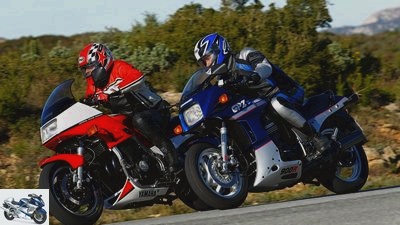
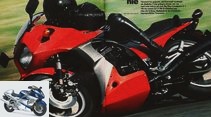
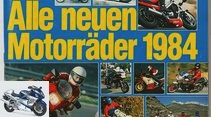
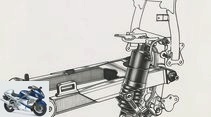
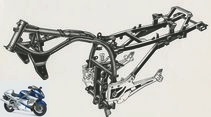
39 photos
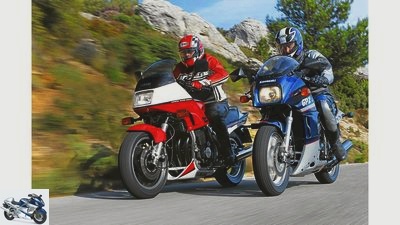
1/39
Hurry with a while, always slowly with the young horses – sayings like these were definitely not up for debate when the new, future-oriented big bikes were developed in the early 1980s.
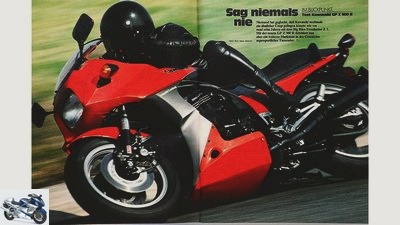
2/39
"The four-cylinder engine of the GPZ 900 is without a doubt one of the most modern and advanced engines in the current one-liter range."
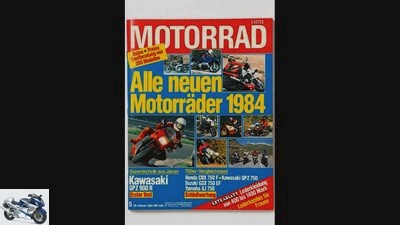
3/39
MOTORRAD 5/1984 with an article about the Kawasaki GPZ 900 R..
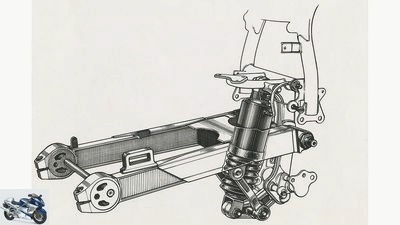
4/39
The air-assisted, adjustable De Carbon shock absorber is supported by the Uni-Trak system on the aluminum swing arm.
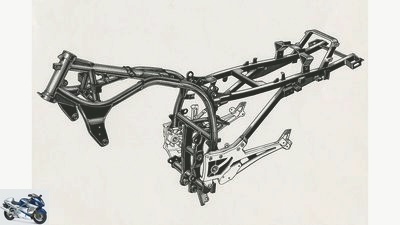
5/39
The chassis of the Kawasaki GPZ 900 R: The tubular steel backbone carries the engine, the aluminum rear section and the two screwed aluminum plates complete the unit.
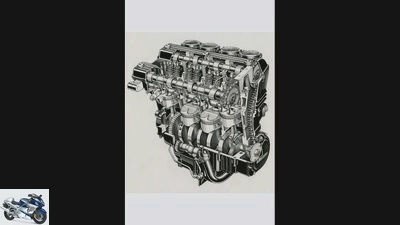
6/39
The engine of the Kawasaki GPZ 900 R is a clever piece of technology: the short-stroke, high-compression four–valve engine pleases with its smoothness and ease of revving. The timing chain running on the left enables a narrow design with straight suction paths.
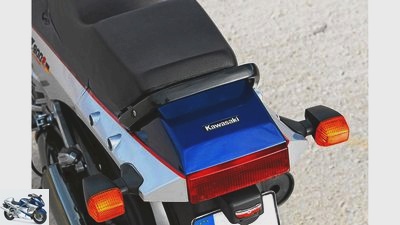
7/39
Straight lines, hard edges: The consistently angular 1980s design characterizes the appearance of the GPZ.
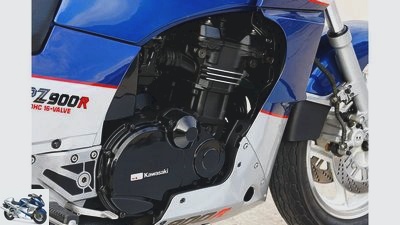
8/39
Can do without cooling fins: The water-cooled, very compact four-cylinder is thermally sound.
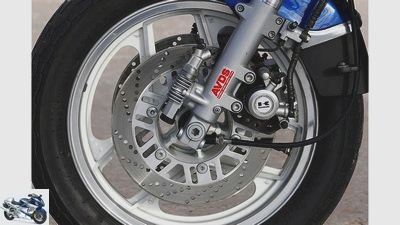
9/39
The effect of the Anti Dive or AVDS (Automatic Variable Damping System) is poor, but that of the brake is enormous.
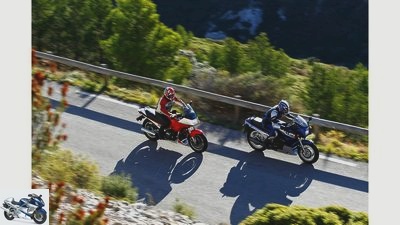
10/39
Strolling is possible, but the sitting posture on the Kawasaki tempts to brisk (re) m pace. The FJ gives you a significantly less stressful driving experience.
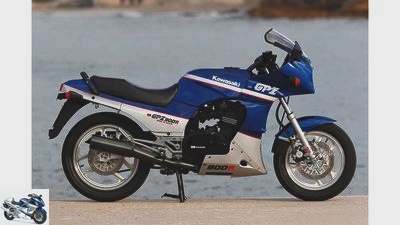
11/39
The streamlined, flat fairing of the Kawasaki GPZ 900 R, together with the small frontal area, leads to a very low air resistance of the GPZ, which helps it to achieve an enormous top speed.
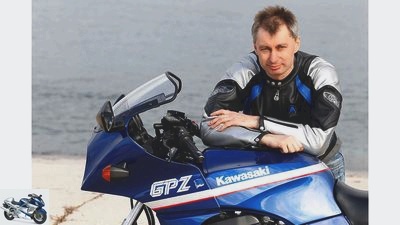
12/39
The opinion of our editors Gerhard Eirich: "Long-lasting racer or lightning-fast tourer? The GPZ 900 R is somehow both."
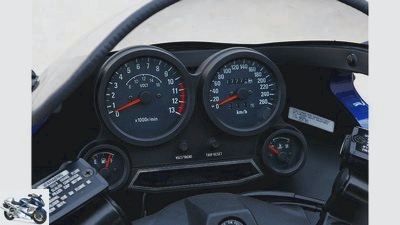
13/39
In the cockpit, the GPZ brings the athlete out: the tachometer is more important, therefore larger and easier to read.
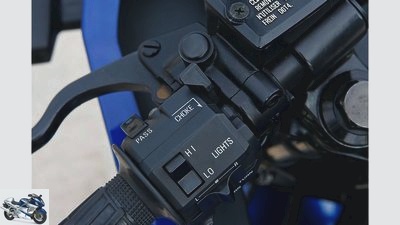
14/39
Small lever, big effect: the choke aid needs to be carefully dosed for a cold start in the morning.
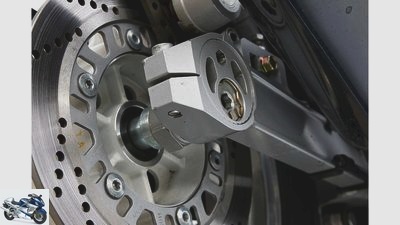
15/39
With the high-quality and practical eccentric chain tensioner, the GPZ was way ahead in its time.
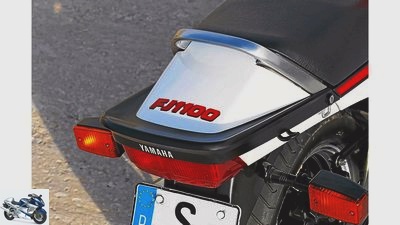
16/39
The sporty-looking rear design with the plastic rear spoiler runs through all FJ 1100/1200 series.
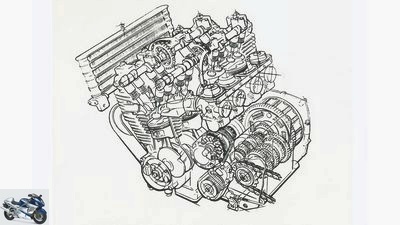
17/39
The newly designed, air-cooled four-cylinder engine of the Yamaha FJ 1100 controls its 16 valves via bucket tappets. In order to save space, the alternator was moved behind the cylinders, and the oil filter was positioned underneath.
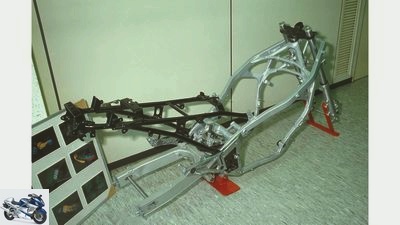
18/39
“Lateral Frame Concept” is what Yamaha calls the new type of frame, the upper and lower beams of which enclose the steering head, giving it a high degree of rigidity. Another positive effect: the entire unit is flatter. The rear frame for the bench is screwed onto it.
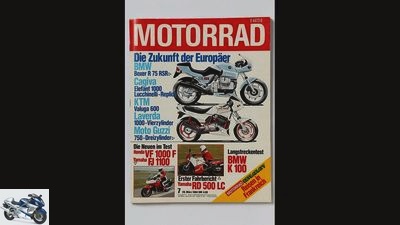
19/39
The test of the Yamaha FJ 1100 in the MOTORRAD 7/1984.
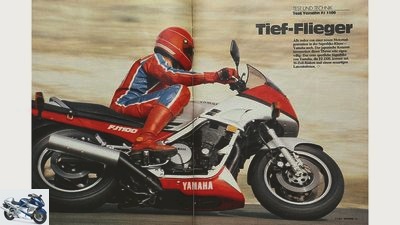
20/39
"With almost unparalleled maneuverability, the 261 kilogram heavy 1100 can be circled around long curves or even tight hairpin bends."
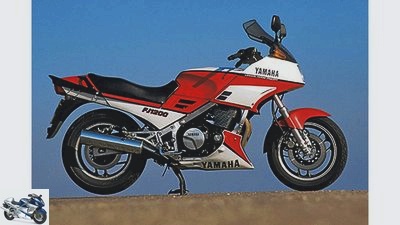
21/39
1986: The FJ 1200 (type 1XJ) with four millimeters more bore replaces the 1100 model. The indicators are now integrated into the somewhat lavish fairing. Price at that time: 13,888 marks.
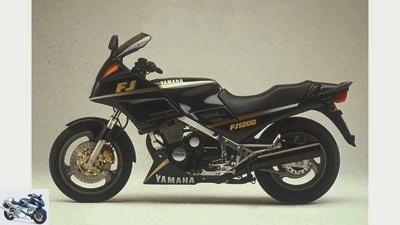
Yamaha
22/39
1988: The second FJ 1200 (type 3CW) underwent significant changes: 17-inch front wheel, new brakes with four-piston calipers, new seat, more expansive fairing. At that time: 14,710 marks.
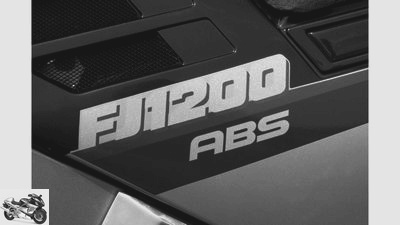
23/39
1991: The last FJ model (type 3YA) has a newly styled fairing. The motor is mounted in silent blocks, the swing arm is made of steel. Available with ABS. Back then: 15,950 marks.
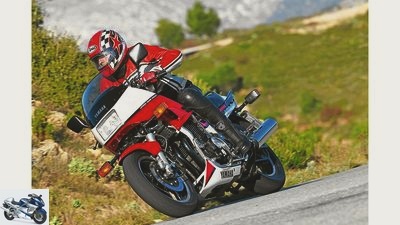
24/39
The Yamaha rolls on small, relatively wide 16-inch rollers. Despite its heavy weight, the FJ is astonishingly easy to tilt.
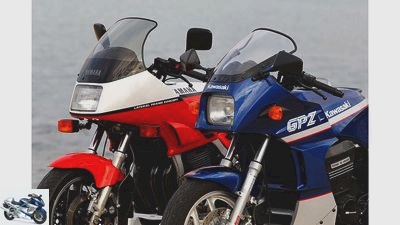
25/39
The common goal for both of them was to create a sporty highlight on the big bikes. On the engine side, both Yamaha and Kawasaki now rely on four valves in their heads.
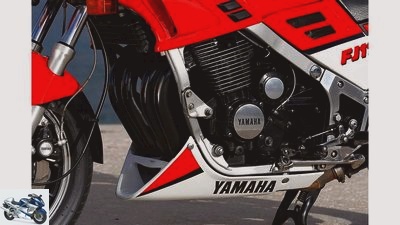
26/39
The beams of the square steel frame are screwed, which makes it easier to dismantle the motor.
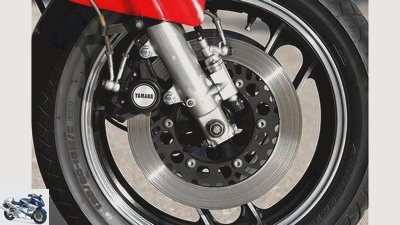
27/39
Rather ineffective: the hydraulic anti-dive system. The brake with internally ventilated discs decelerates passably.
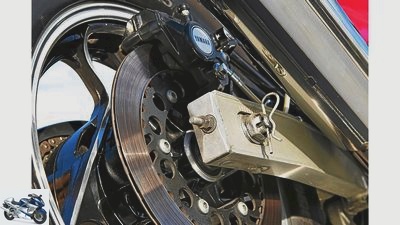
28/39
Aluminum swing arm with a very simple chain tensioner – the FJ shows off the rear with an internally ventilated brake disc.
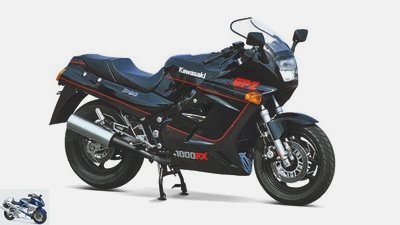
29/39
1986: The beefy, open 125 hp GPZ 1000 RX rolls front and rear on 16-inch wheels and is offered in parallel with the 900 series, which is still sold. Back then: 15,560 marks.
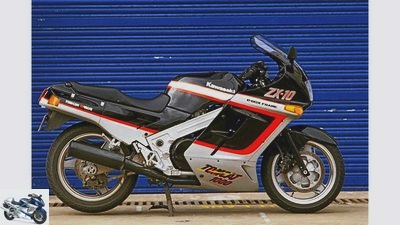
30/39
1988: The ZX-10 is the new top 1000 model with an aluminum bridge frame and extremely effective protective full cladding. Unrestricted, it makes an impressive 139 hp. At that time: 14,790 marks.
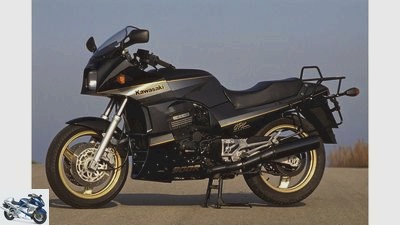
31/39
1990: Many modifications to the GPZ 900 R: larger brake discs with four-piston calipers at the front, new fork (Ø 41 mm), 17-inch front wheel, wider rear wheel. Back then: 14,140 marks.
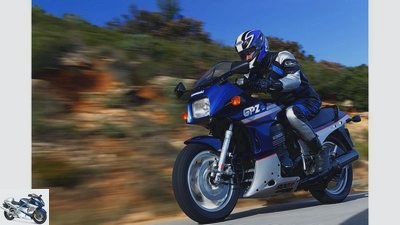
32/39
Independent, but almost timeless: with its angular design, the GPZ 900 R is still a face in the crowd today.
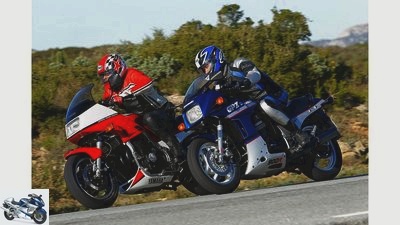
33/39
In 1984, the two machines finally made faces astonished in the motorcycle world and should mark the beginning of a new era.
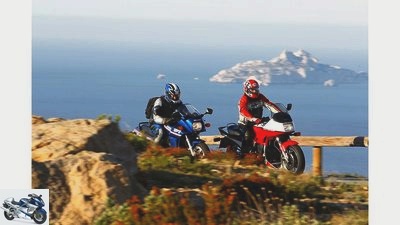
34/39
Different times, different customs: the front wheels of big bikes have never been smaller, and never in motorcycle history have their indicators been larger…
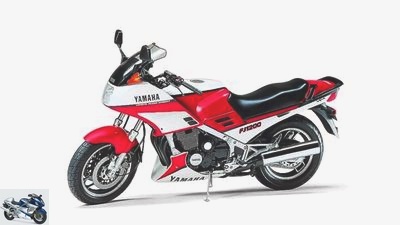
35/39
The tasteful color scheme and the design line that rises consistently towards the rear give the Yamaha FJ 1100 the intended touch of sportiness.
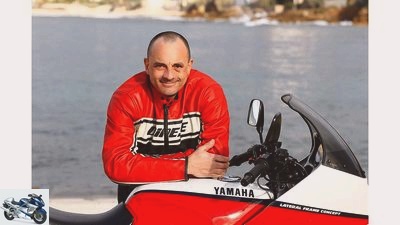
36/39
The opinion of Yamaha owner Walter Mair: "As a late starter, I bought the FJ as my first motorcycle eight years ago. It should be a good-natured big bike with beefy performance characteristics and a discreetly sporty, more upright posture. The Yamaha fulfills all of these criteria and leaves me relaxed even after several hours of driving."
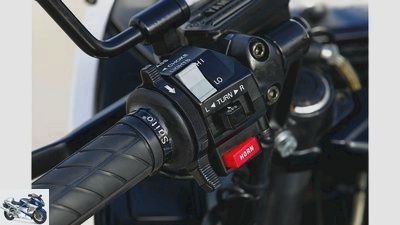
37/39
Clever solution: the choke ring can also be operated with the thumb – Yamaha charm from the 1980s.
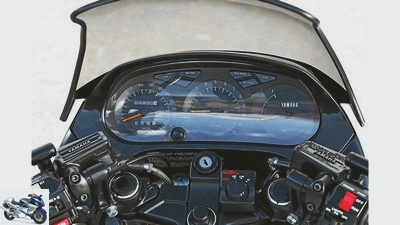
38/39
Large, clear and clear: the cockpit, which is unfortunately not mirror-free, impresses with its sober functionality.
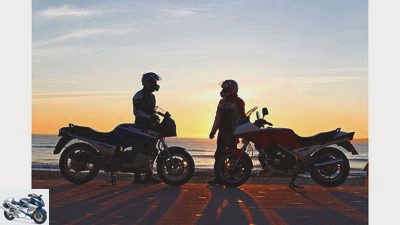
39/39
The silhouettes of the two unequal but equally old bikes are wonderfully unmistakable.
On the move with Kawasaki GPZ 900 R and Yamaha FJ 1100
Big bikes of the 80s
Content of
1984 – The new Kawasaki GPZ 900 R penetrates new driving performance ranges with a 115 hp four-valve engine. Yamaha countered this with an air-cooled four-valve engine and with the FJ 1100 laid the foundation for a sports touring legend.
E.ile with a while, always slowly with the young horses – sayings like these were definitely not up for discussion when the new, future-oriented big bikes were developed in the early 1980s. In 1984 two machines finally made faces in amazement in the motorcycle world and were to mark the beginning of a new era. Each in their own way, yet brothers in spirit.
Buy complete article
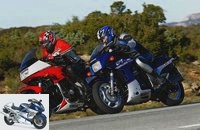
On the move with Kawasaki GPZ 900 R and Yamaha FJ 1100
Big bikes of the 80s
Yamaha and Kawasaki now have four valves in their heads. The latter even went the consistent way to water cooling, while the FJ still relied on the heat dissipation via generously ribbed cylinders. At Kawasaki, the air-cooled four-cylinder series with 550, 750 and 1100 cubic centimeters ran out of air in the truest sense of the word. Despite the injection in the 1100, there seemed to be limits to further sporting developments. Prestigious turbo engines that have been launched in the meantime, at Yamaha in the form of the XJ 650 Turbo, at Kawasaki with the GPZ 750 Turbo, did not bring about the big breakthrough and proved to be a huge blow in terms of sales figures.
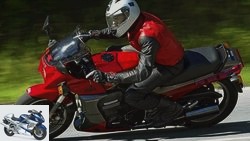
classic
Youngtimer test: Kawasaki GPZ 900 R
Strong then and now: Kawasaki GPZ 900 R
read more
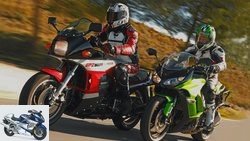
Tourer
Generation comparison
27 years of Kawasaki sports tourers: GPZ 900 R and Z 1000 SX
read more

Used purchase
Buying advice: big bikes
The big bike generation from 1984
read more
Ready to go
Strolling is possible, but the sitting posture on the Kawasaki tempts to brisk (re) m pace. The FJ gives a significantly less stressful driving experience.
Slimming down was the order of the day, the chassis was modernized and the engine concept was completely redesigned. At Kawasaki we are returning to the once so successful displacement of 900 cc, which already helped the original Z1 to today’s legendary success and lasting fame. But instead of relying on the airflow, the GPZ now has four liters of coolant to ensure a healthy temperature balance. GPZ engine guru Inamura designed the valve angle of the four valves per cylinder, now installed for the first time at Kawasaki, to be very pointed, which enables flat combustion chambers and high compression to improve performance. The unbridled GPZ quad developed 115 hp abroad, for Germany it had to be throttled to 100 hp by means of a modified carburetor cover. Still enough to make you sit up and take notice, because even the German version runs a whopping 240 km / h with the driver lying down. It will soon no longer be a secret that the performance of the throttled version is scattered upwards – at least the owners are pleased.
The high power output of the engine is also made possible by the relocation of the new “Silent Chain” control chain to the left, which now creates space in the middle for short, straight intake paths. Enough with the theory for now – the GPZ is ready to leave the hotel car park and needs to be moved. MOTORRAD Classic has taken off from winter, but the morning hours are still fresh here in sunny southern France. With the choke lever fully pulled, the starter only has to do the organ briefly until the foursome comes to life and, as is typical of Kawa, first yelps, and then warms up with increased idle gas. The engine noise is well muffled by the water jacket. The pithy grumble comes from the black chrome-plated end pots and signals readiness to perform.
The GPZ looks narrow and slender, a bit spiky and long-legged, especially in comparison to the more bulbous FJ. The driver assumes a sporty, stretched posture, hands stretched to the narrow, strongly cranked handlebars. A clear signal. Despite hydraulic actuation, the clutch is not very smooth, but the gears, by the way, now a total of six, engage in a dry and precise manner. The almost ten year old Dunlop front tire suggests that our 1988 GPZ has hardly been moved in recent years, which explains the low mileage of barely 18,000 kilometers. Owner Wolfgang Kleinschmidt, who kindly left the GPZ to us, only bought it a year ago and is delighted with the great condition of the 26-year-old lady. Today I enjoy the amazing handiness at low speed, almost as a substitute for it.
The GPZ is cracking powerfully
Independent, but almost timeless: with its angular design, the GPZ 900 R is still a face in the crowd today.
The 16-inch front wheel, despite its impressive width of 120 millimeters, as well as the deep installation position of the engine, promote handling. This is made possible by the compact design – the 900 engine is a stately 123 millimeters narrower than the air-cooled quad of the most powerful 1100 GPZ to date. A good argument for the new design. A lot has happened in terms of smoothness as well. The balance shaft rotating under the crankshaft at twice the speed does a great job, vibrations can hardly be felt at any speed, and if so, only very subtly. The bright howling and whistling of the primary drive at almost any speed, on the other hand, is rather annoying in the long run and almost suggests a defect if you didn’t know better.
With increasing speed, however, this is drowned in the rush of wind, and the 900er comes up tremendously. It hangs splendidly and easily dosed on the gas, takes commands spontaneously at any time. Open the gas at 2000 rpm? No problem. The 900 pulls in gently, but not too firmly, closes a shovel from 4000 tours, takes another breath, and then picks it up with vehemence from around 7000 rpm, which still demands respect today. You could turn up to the red zone at 10500 rpm and beyond, but you neither have to, nor do we want this today. No question about it, the GPZ was rightly considered the sportiest and fastest production bike back then and it still pulls my arms out to this day. At high speed on the straights, the Kawa lies like a board, unfortunately in long curves it is also stoic and stubbornly defends itself against any course changes. The tight, even hard basic chassis setting is both a blessing and a curse. The Japanese have put enormous effort into the frame and especially the fork and, in addition to the anti-dive system, built in an automatically varying damping system for the compression stage.
With all the sportiness also suitable for touring
The streamlined, flat fairing of the Kawasaki GPZ 900 R, together with the small frontal area, leads to a very low air resistance of the GPZ, which helps it to achieve an enormous top speed.
But if you say A for gasping, you also have to say B for brakes. The double disc at the front leaves nothing to be desired and, despite its comparatively simple design with single-piston floating calipers on 280 mm discs (only four-piston calipers and 300 mm discs were introduced from model year 1990), it doesn’t seem too snappy. The rear brake, on the other hand, acts more digitally, i.e. all or nothing and can easily lock the rear wheel if you step inadvertently. The fact that the GPZ wanted to be suitable for touring in spite of its sportiness is proven by the large 23-liter tank, which does not show its capacity directly. And because touring riders make a lot of distance and expect a reliable vehicle, MOTORRAD once put the 900s through an endurance test over 100,000 kilometers, which the Kawa completed with flying colors, i.e. without failures.
The final dismantling revealed a technically healthy condition; after replacing a piston with too much running play, the Japanese could have been reassembled and sent on tour. Our Foto-GPZ has many years to go before this mileage. Today we only contributed 250 kilometers to it, had a lot of fun and refreshed old memories. After all, my experiences with GPZ and FJ go back a while. I owned both of them in the late 1980s and early 1990s. Okay, I’ll admit it, I only had the small GPZ variant, the 750 with smaller bore and stroke dimensions (70 x 48.6 mm) and only 92 hp, but otherwise identical features and chassis. The little sister admittedly did not uproot any trees and was not significantly cheaper, which is why it was taken out of the program again after a short, rather unsuccessful construction period.
The FJ is the sporty tourer
The Yamaha rolls on small, relatively wide 16-inch rollers. Despite its heavy weight, the FJ is astonishingly easy to tilt.
Having fun with the FJ 1100 feels different, and the memories relate to other journeys you have once experienced. But above all, the FJ, together with its 1200 successor, has earned the reputation of a reliable, durable sports tourer, with an emphasis on tourers. The seating position on the wider and more massive than the Kawa-looking Yamaha fits in with this. The handlebars are higher and more expansive, the posture more upright, the leg angles more relaxed – this is how you can easily endure many hours in the saddle. At Yamaha, too, the development of the big bike segment had reached a kind of dead end in the early 1980s.
The XS 1100 was and remained a heavy cardan tourer, which, even as the XS 1.1 Sport derived from it, could not be put on the athlete’s crown with a clear conscience. A reorientation was the order of the day. The air cooling was kept true, almost everything else was turned inside out. In order to meet the sporting demands, power was needed (125 HP without throttling abroad), which could best be achieved with modern four-valve technology. 16-inch wheels were considered an insider tip for handiness, the completely new steel frame, called “Lateral Frame Concept”, almost encloses the steering head and in some ways is similar to the early Bimota designs. Which is certainly not a disadvantage. The tube for the steering head can be made more torsion-resistant, and the frame is flatter, which in turn benefits the installation position of the mighty 24-liter tank and lowers the center of gravity. The FJ was always considered to be amazingly handy in tests, and my memories are also shaped by how lightly the 261-kilogram truck can be circled around the corner.
The FJ ergonomics fit perfectly
archive
The tasteful color scheme and the design line that rises consistently towards the rear give the Yamaha FJ 1100 the intended touch of sportiness.
So go ahead, put an end to the anticipation and get down to business. The compact seating position immediately looks familiar and I like it now as it was then. The choke ring, operated with your thumb and / or forefinger, makes me smile. Good old Yamaha quirk. As is typical of the FJ, the four-man reports to duty with a sharp look at the starter button and after a short time dispenses with further cold start assistance. It runs mechanically rougher than the GPZ engine, no question about it, but the vibrations that penetrate the handlebars and footrests, especially in the range below 5000 tours, are not really annoying. They only become annoying when they affect the half-shell or the fairing keel – they tear at the screw connections over time.
Nothing of this can be seen on the photo FJ of owner Walter Mair. It was first completely overhauled and restored by the meticulous Franconian after the purchase around eight years ago and is now in top condition. So I enjoy the view of the instruments that show a low four-digit mileage, as well as the relaxed sitting position in the rather low, well-padded saddle. A comparison comes to mind: If the Big Bikes were bicycles, the GPZ would be a racing bike and the more comfortable FJ a Dutch bike. From a purely ergonomic point of view, without any information about the driving dynamics, of course. Because here the FJ with the broad chest of the larger displacement self-confidently pushes itself forward and already pushes just above idle like the proverbial bull. The four-valve engine then pulls through the rev range like the often-cited electric locomotive without stuck and without an explosion in performance and only issues a warning at 9500 rpm when the red range begins. Such an engine is rightly content with only five gears, and actually the first four are only starting aids, because apart from alpine passes and urban stop-and-go traffic, at least one quickly believes, almost everything goes in fifth. At full throttle on the track, the tests at that time showed, the more streamlined GPZ of the FJ clearly pulls away.
Opinions on the two bikes
The silhouettes of the two unequal but equally old bikes are wonderfully unmistakable.
Gerhard Eirich (editor) on the Kawasaki GPZ 900 R
Editor Gerhard Eirich.
Long-lasting racer or lightning-fast tourer? The GPZ 900 R is somehow both. The way the 30-year-old Japanese lady fires at the top from medium speeds can still inspire today. The versatile all-purpose weapon combines the sporting hardness of a sprinter for the racetrack, which cannot be ignored, with the virtues of a long-distance runner. Anyone who has become familiar with the handy, but also with peculiarities, 16/18-inch chassis will experience how much sporty driving fun a freshly baked classic car can be.
Walter Mair, owner of the Yamaha FJ 1100
Walter mair is the owner of the Yamaha FJ 1100.
As a late starter, I bought the FJ as my first motorcycle eight years ago. It should be a good-natured big bike with beefy performance characteristics and a discreetly sporty, more upright posture. The Yamaha fulfills all of these criteria and leaves me relaxed even after several hours of driving. The handling of the quite heavy FJ is astonishing, the chassis and brakes meet my requirements and the engine, which was only completely overhauled a few thousand kilometers ago, will certainly give me carefree fun for many years to come.
Closing words
I notice again today that the slightly more manageable Yamaha does not do anything on winding terrain, it benefits from its successful weight distribution and the small 16-inch model at the rear (Kawa 18-inch rear). The good knee grip thanks to the matching indentations on the tank, the relaxed sitting posture and the successful chassis design make course corrections and turning into child’s play. The soft design of the sturdy fork with (almost ineffective) anti-dive system and the central spring strut, which can be steplessly adjusted via a chain in the preload and in the rebound damping, continue to help on poor back roads.
Of course, the FJ cannot hide a certain tendency to stand up when braking in an inclined position, as can the GPZ: Both roll on a front wheel in the bulky size 120 / 80-16. No problem, I quickly returned to the good old FJ and feel the sporting spirit awakening, which the 1100 was once born with.
With the Bridgestone BT 45 installed, I’m not worried about tire grip. More about the braking effect: Although the FJ has internally ventilated 282 millimeter discs at the front and rear, the finely adjustable two-piston fixed calliper brakes don’t bite as hard as the Kawa stoppers. No matter. In any case, the Yamaha somehow manages to feel like a big bike, i.e. powerful and sovereign, without appearing heavy or even cumbersome. And the charm of the beefy, air-cooled four-valve valve with its muffled, robust sound still works today.
No wonder, then, that the engine in its evolutionary stage still lives on in the XJR 1300 three decades later, just as the GPZ four-cylinder has survived for almost three decades as the basis for larger-displacement Kawa engines. Power in the long run.
Related articles
-
Kawasaki 900 Z1, Suzuki GSX-R 750, Yamaha YZF-R1 and BMW HP4
www. 44 pictures www. 1/44 We bow to engineering and do what God expects from PS. We enjoy…
-
Kawasaki ZL 1000 and Yamaha Vmax
Stefan Wolf 38 Image archive 1/38 The “new” Vmax, in the range since 2008, also boasts superlatives in terms of performance, acceleration and …
-
Aprilia Tuono V4 1100 Factory and Yamaha MT-10 SP in the comparison test
www.factstudio.de 17th photos fact 1/17 Aprilia Tuono V4 1100 Factory and Yamaha MT-10 SP are two naked bikes based on a super sports motorcycle. fact…
-
On the move with Honda CB 1100 F and Kawasaki GPZ 1100 B2
www.factstudio.de 29 photos factstudio.de 1/29 Picture gallery: Honda CB 1100 F and Kawasaki GPZ 1100 B2 on the move. factstudio.de 2/29 Honda CB 1100 F…
-
Kawasaki KH 400, Yamaha DT 400, Yamaha RD 400
bilski-fotografie.de 27 pictures bilski-fotografie.de 1/27 In the well-stocked, clear RD cockpit, you will find all the necessary warning lights …
-
Comparison test of supersports: Honda CBR 600 F, Kawasaki ZX-6R, Suzuki GSX-R 600, Yamaha YZF 600 R
Comparison test of super sports cars: Honda CBR 600 F, Kawasaki ZX-6R, Suzuki GSX-R 600, Yamaha YZF 600 R Let’s twist again Wake up, people. In the 600s …
-
On the move with a Kawasaki Z 1000 and Zephyr 1100
www.bilski-fotografie.de 36 pictures www.bilski-fotografie.de 1/36 Genetically not related, but they belong to the same family: Kawasaki Z 1000 and …
-
On the move: Triumph Bonneville and Yamaha TX 750
www. 40 pictures , archive 1/40 When comparing the British original Triumph Bonneville 750 with the Japanese answer Yamaha TX …
-
On the move: Benelli 750 Sei, Honda CBX 1000, Kawasaki Z 1300
Bilski 17th photos Bilski 1/17 Who is the widest in the whole country? The angle of spread of the driver’s legs provide information. Bilski 2/17 With…
-
Honda, Kawasaki, KTM, Suzuki and Yamaha Crosser in the test
Honda comparison test: Motocross MX2 (up to 250 cm³) Crosser from Honda, Kawasaki, KTM, Suzuki and Yamaha in the test For two years the Suzuki RM-Z has dominated …